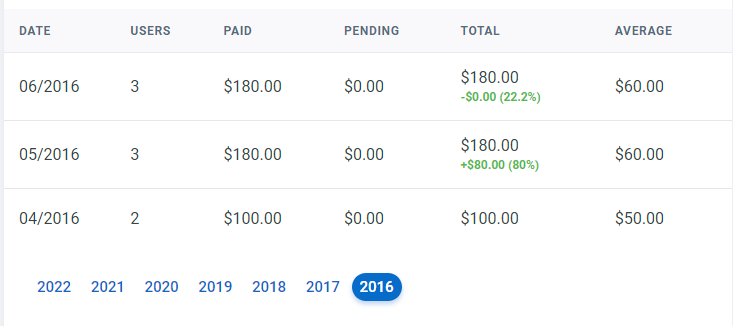When I started building Gymdesk at the end of 2015, I had no idea how long it would take for it to be profitable enough that I could live from it full time.
At previous companies and roles I had primarily been the technical founder / lead, focused mostly on building the product and underlying infrastructure. I had much less experience with the marketing and operational aspects of running a business.
In my naivety, I had hoped that I could focus on Gymdesk full time and hopefully reach enough revenue within the 6 months runway I had built to continue working on it without taking on outside work.
I was wrong.
In reality it took 3 whole years for the business to grow to the point it could provide for me full time. I had a lot of learning to do –
- Learn about the target audience and their needs ( -> product-market fit)
- How to convey what it is we’re building and how to differentiate from the competition
- How to gain awareness for our product
- How to run a business as the sole operator
There was much more to do than just building the product – which was the part I was most confident about – that in hindsight I likely underestimated.
Taking a full time job but keeping the flame going
After launching the product at the beginning of 2016, I spent close to half a year trying to build a customer acquisition funnel. I had very little idea what I was doing at the time, or rather my expectations were somewhat misaligned with reality.
I focused mostly on organic traffic, which is a channel I was previously quite experienced with, but one that also evolves very rapidly. It’s also a channel that can take quite a while to get going. I was mostly doing content marketing – blogging on our website, doing guest posts on various publications, posting links on reddit and other social media – but our search rankings and traffic was barely moving.
This is how our revenue looked after 6 months:

Yes, you read it right – the revenue starts in April since I had 0 customers before then. It was around then that it started dawning on me, that getting this to profitability might take longer than expected, or might not happen at all.
So I got a job.
It started off as contract work that I did for about 6 months, during which I continued to work on building the product. One of the benefits of having steady income is that I could focus more on improving the product based on user feedback, rather than worrying incessantly about paying customers to keep me alive.
This would become the foundation of success for the product. I started building a process for processing, assimilating and incorporating user feedback into the feedback. But more on that later.
As fate would have it my contract work worked out too well, and I was offered a full time position that I ended up taking. I put in a stipulation that I would only be working 4 days a week. This gave me 3 days a week to continue working on Gymdesk.
Naturally, working on a side project over the weekend, with an extra day, is less productive. When you have a day job during the week that drains your energy and creative resources to an extent, you can’t always give 100% during the time you have available to work on your product. And at times, I would skip several weeks at a time, using the weekends to rest instead of burning myself out.
You see, one of the lessons I learned at my previous company, Binpress, which raised VC money but eventually got sold for 30 cents on the dollar, is that working harder does not equate having more success. This time I would try to only work on this business when I feel fresh and creative, and treat it more as a marathon than a sprint.
Steady and consistent
By the end of 2016, Gymdesk had generated $5.3k in total revenue, and had $1.2k in MRR (monthly recurring revenue). This after building it for 4 months at the end of 2015 and spending a whole year trying to acquire customers and improving the product.
Compared to my day job compensation, this did not seem an effective use of my abilities, however since I was not dependent on it financially, I could it easy and just enjoy helping gym owners and understanding their business better.
If I had asked people what they wanted, they would have said faster horses.
Henry T Ford
Users that would try the product out would send in requests that usually started with “I like it overall, but it would be really great if it could do XYZ”. Despite my developer instincts, I began to develop an inquisitive approach, starting a dialog with them on what is the goal they are trying to achieve.
And as I gained a better understanding of their use-case, and by integrating feedback from other users over time, I was able to develop a process for improving the product in a way that benefited most users.
Reaching Profitability
This process continued for another 2 years, and by the end of 2018 we had reached $10k in MRR. It was at this point that I made the decision to quit my full time job and resume working on Gymdesk full time.
It took 6 more months for me to effectively pull the trigger, as I had a critical function at the company I was working at, and I didn’t want to leave them hanging. Finding a replacement took a while, but I eventually moved forward to working on Gymdesk full time in June 2019. We ended the year with $12k in MRR, and I was looking forward to a strong year in 2020 (little did I know what 2020 would bring… but that’s a story for another time).
Gymdesk is no longer a one-man operation – it’s an actual company, employing 9 full-time employees and growing rapidly. It serves thousands of small businesses, helping them run their own business, and product continue to evolve every day.
We have been profitable every month since early 2016. I have been investing back and growing back the business conservatively, making sure we never outpace our revenue.
My goal was never to build a massive tech giant unicorn business. Knowing what I know now, I strongly believe this process is very repeatable. Focus on a niche, become an expert on the use-cases of the target audience, and consistently iterate and improve your offering.
The subscription SaaS business model is such, that if you do not over extend, and are consistently making forward progress – however small it may be – success is mostly a matter of being persistent.
I’m wrapping up this post on Christmas eve / Hannukah – so I wish you all happy holidays and a great 2023. I’ll be writing more on the path Gymdesk took in 2020 and beyond in future posts, so make sure to subscribe if you’re interested in reading more articles like this.




